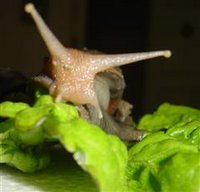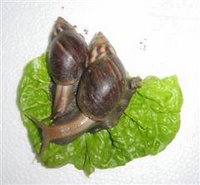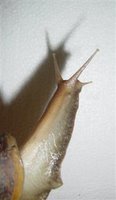Giant African Land Snails

It is probably illegal to keep Giant African Land Snail (GALS) were you live. Check! It isn’t worth breaking the law to get a pair, especially with so many other snail species around. Here in the Philippines they have been accidentally introduced and are now an invasive species. If you can get GALS, they make stupendous pets (like all the pets I’ve listed so far). Otherwise, most of the advice I’m about give can be applied generally to many other snails.
Rewards: Nothing beats the feeling of wet snail in the morning ...
Difficulties: Speaking about “responsible” pet ownership, it is essential to note that this species can devastate native ecosystems and agriculture, as it has done here in the Philippines. Please do not import/keep snails illegally. Also, there is ample info on the web about breeding snails, but snails produce so many young that it is immensely difficult to cater for the needs of each and every one in a responsible, long-term manner. Therefore I will not include a breeding section in this discussion. Although GALS are hermaphrodites, you can make it unsuitable for them to breed by not providing leaf litter (worked for me…) if you intend to keep more than one at a time.
Housing: Snails have remarkably simple housing requirements – making them ideal, low budget and low maintenance pets. However, GALS faeces are not a pleasant sight and food in their enclosure rots quickly because they must be kept warm and moist. For my GALS I spray their aquarium a couple of times a day with a hand mister. As GALS like to dig through soil I recommend it as substrate. They will very often also defecate in this, which keeps the sides of the aquarium cleaner. I usually also keep earthworms in the soil, as they keep it aerated, and blind snakes to eat any small organisms (blind snakes, in my experience, do not make good pets. Even as pest controllers, I usually only kept each blind snake for about two weeks before releasing it back into my garden.). Just like with tree frogs, if your GALS are spending a long time on the side of the aquarium, the things inside it aren’t suitable. My setup is a ten gallon aquarium with two snails with about three inches of soil substrate with the remains of plants on either end (I’d suggest plastic plants, but makes sure you wash them thoroughly before using them) and a piece of plastic on which I place their food. I’ve scattered a few pebbles around so that the snails can spend time exploring around them (and, yes, GALS do ‘explore’).
 Feeding: I generally feed gals kitchen scraps – not that I’m sexist or anything of the sort... Any fruits or vegetables you’ve got left over: wash them thoroughly and give them to your GALS. However, do note the “Wash them Thoroughly” part. Remember that your GALS are molluscs. Also, snails produce their own shell, which requires calcium. It is essential that you provide your GALS with cuttlefish bone. However, do not just leave a piece in their aquarium as they are likely to spread slime all over it and then not eat it after all. I give them small, 3X3cm pieces every four or five days (I always have cuttlefish bone around for my lovebirds). If you happen to not have any cuttlefish bone try a piece of egg shell. Apparently they will eat that as well (I’ve never had to try).
Feeding: I generally feed gals kitchen scraps – not that I’m sexist or anything of the sort... Any fruits or vegetables you’ve got left over: wash them thoroughly and give them to your GALS. However, do note the “Wash them Thoroughly” part. Remember that your GALS are molluscs. Also, snails produce their own shell, which requires calcium. It is essential that you provide your GALS with cuttlefish bone. However, do not just leave a piece in their aquarium as they are likely to spread slime all over it and then not eat it after all. I give them small, 3X3cm pieces every four or five days (I always have cuttlefish bone around for my lovebirds). If you happen to not have any cuttlefish bone try a piece of egg shell. Apparently they will eat that as well (I’ve never had to try).
Final suggestions: As I’ve said, remember that snails are molluscs. This has several implications. First of all, their skin must be kept moist. Therefore, if you need to handle them, make sure your hand is wet. Secondly, they can readily absorb any chemicals through their skin. If you wash your hands with soap before touching your snails make sure you rinse all the soap off with ample water. I’d suggest you don’t use soap if at all possible. Never use bleach in their aquarium. These snails can become rather accustomed to being handled, but keep in mind that you must, I repeat, wash you hand before touching them, and then wash your hands again after you handle them. Also, be immensely careful if pulling your snail of any surface. They can adhere to the sides of an aquarium as if stuck with glue, and yanking them off could harm, even kill your snail. Let them crawl onto your fingers (even if they do this quite literally at a snail’s pace) rather than pulling them by the shell. If they don’t teach you anything else, GALS will definitely teach you patience…


2 Comments:
Such snails were being raised and cultured for food consumption out here in africa, it is consider as a specialty food out here and a bunch of snail (around 6 pcs) will cost around 20-25 usd. It really grow big..as in big compare to our own philippine variety.
Apparently someone had suggested eating these snails as a way of controlling their populations here in the Philippines... wasn't a very poppular idea :-)
Post a Comment
<< Home